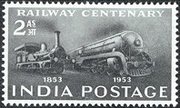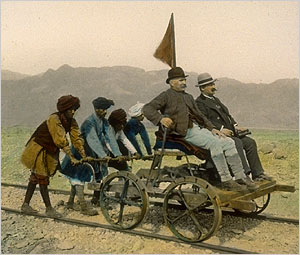Indian Railway History

In 1853, there was not a single kilometre of railway line in India. But within decades, a series of pioneering steps taken by the British engineers and officials gave the subcontinent a new lifeline that throbbed with vitality ensuring connectivity and industrialisation.
Hence, it was not surprising that by 1929 there were 66,000 km of railway lines serving most of the districts of the country.
At that point of time, the railways had a net worth of £687 million, carried over 620 million passengers and nearly 90 million tonnes of goods a year.
A group of private companies owned and operated the Indian Railways then. In the nascent stages, the military engineers of the East India Company contributed much to the birth and growth of the IR. Later on the British Indian Army took up the responsibility during the war time.
Debut show in 1853 from Thane to Mumbai
 In 1845, the Indian Railway Association was formed with Sir Jamsetjee Jejeebhoy and Honourable Jaganath Shunkerseth (known as Nana Shankarsheth) as the founding members. Soon, this association became part of the Great Indian Peninsula Railway (GIPR) and the Indian duo was among the ten directors of this new company.
In 1845, the Indian Railway Association was formed with Sir Jamsetjee Jejeebhoy and Honourable Jaganath Shunkerseth (known as Nana Shankarsheth) as the founding members. Soon, this association became part of the Great Indian Peninsula Railway (GIPR) and the Indian duo was among the ten directors of this new company.
With a bold vision, Shunkerseth took part in the maiden train journey between Bombay and Thane on 16 April 1853. The train was rudimentary with just 14 carriages drawn by three locomotives named Sultan, Sindh and Sahib. The rail track was 21 miles in length and the journey took 45 minutes.
From 1857 onwards, it was left to Robert Maitland Brereton who with a pioneering vision took up the expansion of Indian Railways.
The Calcutta-Allahabad-Delhi line was opened in 1864. The Allahabad-Jabalpur branch line of the East Indian Railway was flagged off in June 1867. Brereton linked these routes with the GIPR thus resulting in a combined network of 6,400 km.
It was possible to travel directly from Bombay to Calcutta via Allahabad as the route was thrown open on 7 March 1870. This railway line later on inspired French writer Jules Verne to pen a book called ‘Around the World in Eighty Days'.
During the opening ceremony, the Viceroy Lord Mayo said, "it was thought desirable that, if possible, at the earliest possible moment, the whole country should be covered with a network of lines in a uniform system."
British funding for Indian Railways
By 1875, the British companies invested £95 million in the Indian Railways which would help in the transport of cotton and other raw materials from the hinterland to Bombay harbour from where it is shipped to London to feed its textile industries.
The railway network swelled to 14,500 km by 1880 mostly travelling inwards from major port cities of Bombay, Madras and Calcutta. India began producing its own locomotives in 1895 and engineers were sent to Uganda to help them build their railways
Govt-owned company
GIPR became a government-owned enterprise in 1900 and began to expand its network to Assam, Rajasthan and Andhra Pradesh. Following the changes brought by the IR, other princely states of India began to have their own railway systems.
A Railway Board was formed in 1901, though Lord Curzon had all the powers. But it was brought under the Department of Commerce and Industry. The new board had a railway official as its chairman and two other members – a manager from England and a company agent. The IR began to make profit for the first time in 1901.
All railway companies were taken over by the British government in 1907 and the first electric locomotive was introduced in 1908.
During the World War-I, railways was used extensively by the British to amass men and material for the war purposes. At the end of the war, the IR was in a perilous state and about to collapse.
Sir William Acworth mooted the idea of a central management for the IR having a total network of 61,220 km in 1920. Following a report submitted by him, the government took over the management of the Railways and further separated its finances from other revenues.
Revenue boom and depression
During the 10 years between 1920 and 1929, the Railways rode high on windfall profit. However, the Great Depression (1929-30) gave a crippling blow to the IR in the next eight years.
The Second World War compounded the misery of the IR. Trains were sent to Middle-East and later to Far East in the fight against the Japanese.
Railway workshops were converted into ammunition depots and some tracks were plucked out for use in other countries for fighting the enemy.
Indian Railways by name and spirit
The country inherited a decrepit rail network in 1947 after Independence and Pakistan got nearly 40 per cent of railway lines.
Many stretches had to be rerouted through Indian territory and new ones were constructed to connect important cities such as Jammu. A total of 42 railway systems including 32 lines owned by the former princely states covering a distance of 55,000 km were merged into the grand Indian Railways.
Zonal divisions
A total of six zones came into being in 1952 and with economic progress, the IR began to set up production units to manufacture locomotives, coaches and rolling stocks. Further, route electrification through AC lines commenced soon for electric trains.
Steam locomotives were phased out in 1985 and computerisation of reservation was first tried out in Bombay in 1987.
In 1989 the train numbers were standardised to four digits and the entire railway reservation was computerised through the railway’s internet in 1995. Konkan Railway was formed in 1998 to open a network through the Western Ghats.
In 1984, Kolkata was the first in the country to get a metro rail system, followed by Delhi Metro in 2002, Bengaluru’s Namma Metro in 2011 and Mumbai Monorail (cum Metro) in 2014. Chennai will be getting its full fledged Metro Rail (trial runs are over and waiting to be inaugurated) offering an efficient mode of mass rapid transit system within the city.